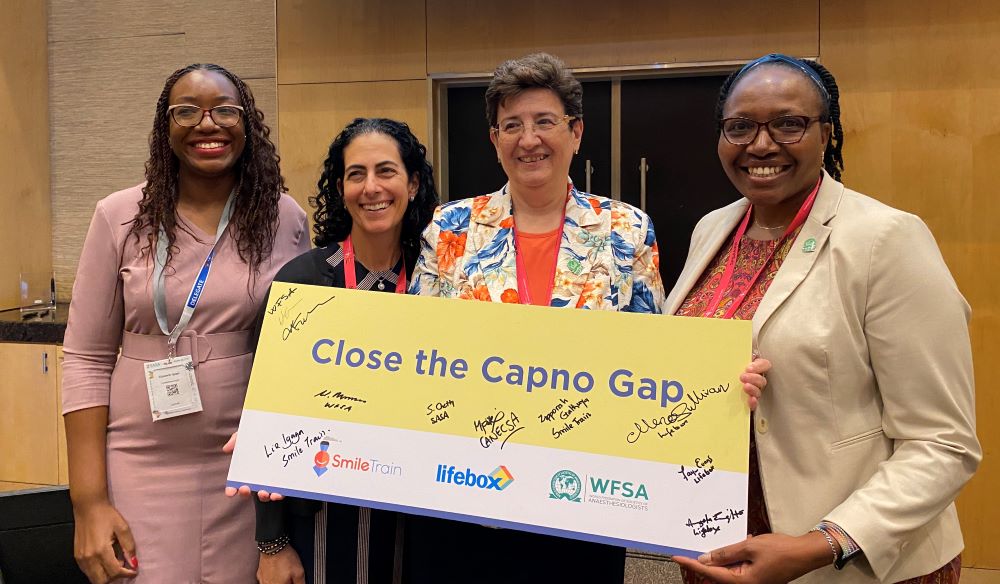A coalition of global health organizations led by Lifebox, Smile Train, the World Federation of Societies of Anaesthesiologists (WFSA), and the South African Society of Anaesthesiologists (SASA) have united to address a critical gap in anesthesia safety: the lack of capnography in low-resource settings, a situation that is putting countless lives at risk.
During a press conference held at the ALL Africa Anaesthesia Congress in Johannesburg South Africa, 16 September, 2024, these organizations signed an action letter calling for the inclusion of capnography as essential monitoring equipment in anesthesia guidelines.
“Including capnography as essential monitoring equipment is a vital step towards enhancing patient safety during surgery,” said Dr. Elizabeth Igaga, Director of Programs Safety at Smile Train. “By advocating for its integration into anesthesia guidelines, we are not only setting a new standard for safer surgical care but also ensuring that every patient, regardless of where they are, has access to life-saving technology.”
Capnography has been used widely in operating rooms in high-income countries for over three decades. Its introduction in the United States in 1991 led to a dramatic decline in anesthesia-related complications and deaths. Yet, capnography remains largely unavailable across most low-resource-setting operating rooms, with research showing there is often a 100% gap between the need for capnography and its availability in low-income countries.
A capnograph is the best tool for detecting a leading cause of anesthesia-related complications and deaths in low-resource settings: the misplacement of the breathing tube supplying oxygen to the patient. Without an oxygen supply, the patient will suffer catastrophic harm in a matter of minutes.
“A capnograph is not just a tool it’s an essential tool,” emphasized Dr. Tihitena Negussie, Global Clinical Director of Lifebox. “By integrating capnography into the standard practice of anesthesia worldwide, particularly in low-resource settings where I work, we can prevent countless avoidable complications and save lives. This coalition and the signing of this action letter represent a crucial moment in our collective effort to improve surgical safety.”

The action letter calls on the World Health Organization and national decision-makers to accelerate the adoption of capnography in low-resource settings by taking the following three immediate actions:
● Upgrading capnography in the WHO-WFSA International Standards for a Safe Practice of Anesthesia from “recommended” to “highly recommended”.
● Including capnography alongside pulse oximetry in the WHO Surgical Safety Checklist as required equipment for safe surgery.
● Incorporating capnography as essential in national anesthesia guidelines.
“The WFSA is committed to advancing anesthesia safety worldwide, and capnography is a cornerstone of that mission,” stated Professor Daniela Filipescu, President of the World Federation of Societies of Anaesthesiologists (WFSA). “The upgrade of capnography’s status in global guidelines is necessary to protect patients and empower anaesthesiologists to provide the best possible care in any setting.”
Ministries of health, professional societies, hospitals, and individual anaesthesiologists from across Africa and beyond participated in the signing of the action letter, marking a unified effort to ensure safer anesthesia practices and significantly improve health outcomes in low-resource settings.
“As anaesthesiologists, our primary responsibility is the safety of our patients,” noted Professor Sean Chetty, President of the South African Society of Anaesthesiologists. “The widespread adoption of capnography in low-resource settings will bring us closer to a world where safe anesthesia is a reality for all. Today’s agreement signifies a crucial advancement towards making this life-saving tool available where it is needed most.”
The absence of capnography in most low-resource settings has been attributed to its high cost and the scarcity of devices adapted to specific local needs. In response to this critical shortfall, Smile Train and Lifebox launched the Smile Train-Lifebox Capnograph, a high-quality, user-friendly, affordable capnograph with sturdy construction and long battery life suited for low-resource settings. Working with the World Federation of Anaesthesiologists (WFSA), the Global Capnography Project (GCAP), and other leaders in global anesthesia, the initiative also developed a comprehensive capnography training package for anesthesia providers. 350 Smile Train-Lifebox Capnographs will be distributed this year in Benin, Ethiopia, the Philippines, and Uganda.
About Lifebox
Lifebox is a global nonprofit that saves lives through safer surgery and anesthesia. Through tools, training, and partnerships, Lifebox addresses the critical gaps in surgical systems to make surgery and anesthesia safer worldwide. Lifebox’s work focuses on three core areas: anesthesia safety, surgical teamwork, and reducing surgical infection. Co-founded by Dr. Atul Gawande in 2011, Lifebox has worked in 116 countries and trained more than 13,000 healthcare providers to make 248 million surgeries safer. To learn more about Lifebox, visit lifebox.org
About Smile Train
Smile Train empowers local medical professionals with training, funding, and resources to provide free cleft surgery and comprehensive cleft care to children globally. We advance a sustainable solution and scalable global health model for cleft treatment, drastically improving children’s lives, including their ability to eat, breathe, speak, and ultimately thrive. To learn more about how Smile Train’s sustainable approach has an immediate and long-term impact, please visit smiletrain.org
About WFSA
WFSA is the foremost global alliance of anaesthesiologists, with 141 member societies representing over 500,000 anaesthesiologists from 150 countries. WFSA unites and empowers anaesthesiologists around the world to improve patient care. Its vision is for universal access to safe anaesthesia.
Find out more at www.wfsahq.org or follow them on social media X , facebook /WFSAORG/; LinkedIn and Instagram
About the Society of Anaesthesiologists of South Africa
The Society of Anaesthesiologists of South Africa (SASA) is a professional body promoting ethical, innovative, patient-centric anaesthesiology in South Africa. SASA is dedicated to the furtherance of anesthesia at both an academic and a clinical level. To learn more about the Society of Anesthesiologists of South Africa, visit sasaweb.com
